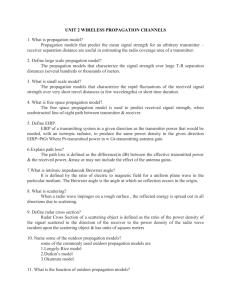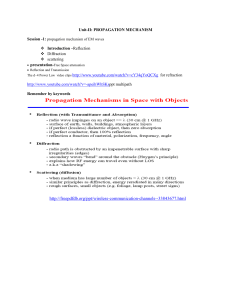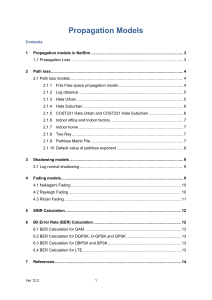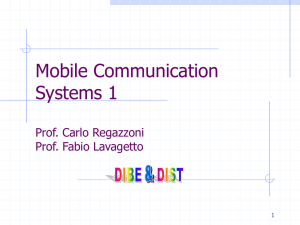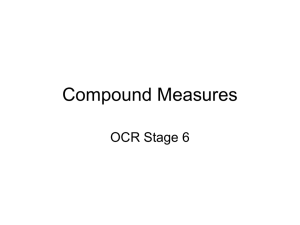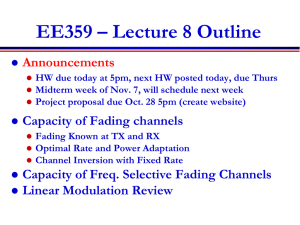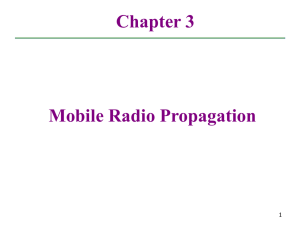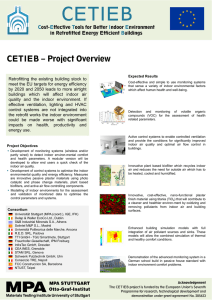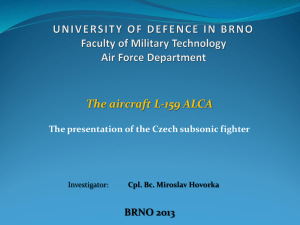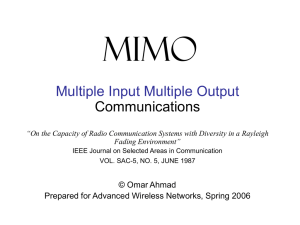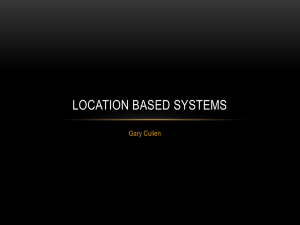B.1.4.1.1 Path Loss Model for Indoor Office Test Environment
advertisement
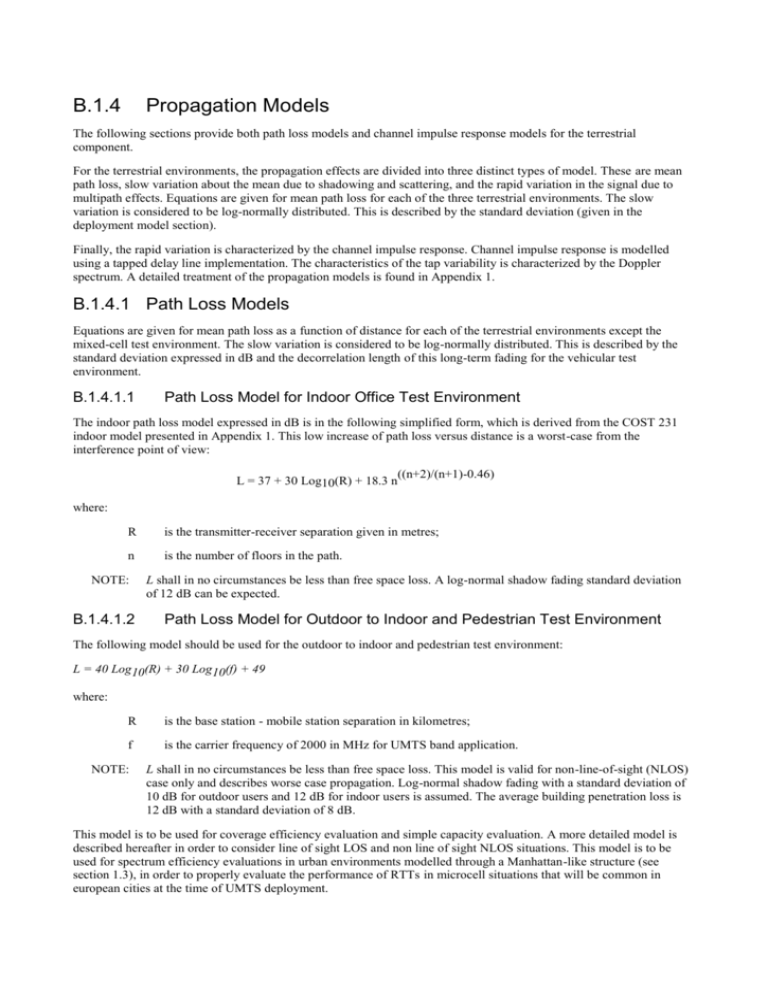
B.1.4 Propagation Models The following sections provide both path loss models and channel impulse response models for the terrestrial component. For the terrestrial environments, the propagation effects are divided into three distinct types of model. These are mean path loss, slow variation about the mean due to shadowing and scattering, and the rapid variation in the signal due to multipath effects. Equations are given for mean path loss for each of the three terrestrial environments. The slow variation is considered to be log-normally distributed. This is described by the standard deviation (given in the deployment model section). Finally, the rapid variation is characterized by the channel impulse response. Channel impulse response is modelled using a tapped delay line implementation. The characteristics of the tap variability is characterized by the Doppler spectrum. A detailed treatment of the propagation models is found in Appendix 1. B.1.4.1 Path Loss Models Equations are given for mean path loss as a function of distance for each of the terrestrial environments except the mixed-cell test environment. The slow variation is considered to be log-normally distributed. This is described by the standard deviation expressed in dB and the decorrelation length of this long-term fading for the vehicular test environment. B.1.4.1.1 Path Loss Model for Indoor Office Test Environment The indoor path loss model expressed in dB is in the following simplified form, which is derived from the COST 231 indoor model presented in Appendix 1. This low increase of path loss versus distance is a worst-case from the interference point of view: L = 37 + 30 Log10(R) + 18.3 n ((n+2)/(n+1)-0.46) where: R is the transmitter-receiver separation given in metres; n is the number of floors in the path. NOTE: B.1.4.1.2 L shall in no circumstances be less than free space loss. A log-normal shadow fading standard deviation of 12 dB can be expected. Path Loss Model for Outdoor to Indoor and Pedestrian Test Environment The following model should be used for the outdoor to indoor and pedestrian test environment: L = 40 Log10(R) + 30 Log10(f) + 49 where: R is the base station - mobile station separation in kilometres; f is the carrier frequency of 2000 in MHz for UMTS band application. NOTE: L shall in no circumstances be less than free space loss. This model is valid for non-line-of-sight (NLOS) case only and describes worse case propagation. Log-normal shadow fading with a standard deviation of 10 dB for outdoor users and 12 dB for indoor users is assumed. The average building penetration loss is 12 dB with a standard deviation of 8 dB. This model is to be used for coverage efficiency evaluation and simple capacity evaluation. A more detailed model is described hereafter in order to consider line of sight LOS and non line of sight NLOS situations. This model is to be used for spectrum efficiency evaluations in urban environments modelled through a Manhattan-like structure (see section 1.3), in order to properly evaluate the performance of RTTs in microcell situations that will be common in european cities at the time of UMTS deployment. The proposed model is a recursive model1, that calculates the path loss as a sum of LOS and NLOS segments. The shortest path along streets between the BS and the MS has to be found within the Manhattan environment. The path loss in dB is given by the well-known formula where L 20 log 10 4d n , dn is the “illusory” distance, is the wavelength, n is the number of straight street segments between BS and MS (along the shortest path). The illusory distance is the sum of these street segments and can be obtained by recursively using the expressions kn kn 1 dn 1 c and dn kn sn 1 dn 1 where c is a function of the angle of the street crossing. For a 90 degree street crossing the value c should be set to 0.5. Further, s n-1 is the length in meters of the last segment. A segment is a straight path. The inital values are set according to: k0 is set to 1 and d0 is set to 0. The illusory distance is obtained as the final dn when the last segment has been added. The model is extended to cover the micro cell dual slope behaviour, by modifying the expression to : L 20 log10 ( n x / xbr , x xbr D( s j 1 )) where D( x ) . j 1 1, x xbr 4dn Before the break point xbr the slope is 2, after the break point it increases to 4. The break point xbr is set to 300 m. x is the distance from the transmiter to the receiver. To take into account effects of propagation going above roof tops it is also needed to calculate the pathloss according to the shortest geographical distance. This is done by using the commonly known COST Walfish-Ikegami Model and with antennas below roof tops : L = 24 + 45 log(d+20) where d is the shortest physical geographical distance from the transmitter to the receiver in metres. The final pathloss value is the minimum between the path loss value from the propagation through the streets and the path loss based on the shortest geographical distance : Pathloss= min(manhattan pathloss, macro path loss) NOTE 1 : This pathloss model is valid for microcell coverage only with antenna located below roof top. In case the urban structure would be covered by macrocells, the former pathloss model should be used. B.1.4.1.3 Path Loss Model for Vehicular Test Environment This model, based on the same general format as in section 1.2.1.2, is applicable for the test scenarios in urban and suburban areas outside the high rise core where the buildings are of nearly uniform height. -3 L= 40(1-4x10 hb)Log10(R) -18Log10(hb) + 21Log10(f) + 80 dB. Where: R is the base station - mobile station separation in kilometres; f is the carrier frequency of 2000 MHz; hb is the base station antenna height, in metres, measured from the average rooftop level. To quantitatively evaluate each SRTT, the base station antenna height is fixed at 15 metres above the average rooftop (hb = 15 m). Each proponent has an option to specify an alternate base station antenna height to optimize coverage and spectrum efficiency in their proposal. 1 J.E. Berg , “A recursive Method For Street Microcell Path Loss Calculations”, PIMRC ‘95, Vol 1, pp 140-143 Considering a carrier frequency of 2000 Mhz and a base station antenna height of 15 metres, the formula becomes : L = 128.1 + 37.6 Log10(R) NOTE 1: L shall in no circumstances be less than free space loss. This model is valid for NLOS case only and describes worse case propagation. Log-normal shadow fading with 10 dB standard deviation are assumed in both urban and suburban areas. NOTE 2: The path loss model is valid for a range of hb from 0 to 50 metres. B.1.4.1.4 Decorrelation Length of the Long-term Fading The long-term (Log-Normal) fading in the logarithmic scale around the mean path loss L dB is characterized by a Gaussian distribution with zero mean and standard deviation. Due to the slow fading process versus distance x, adjacent fading values are correlated. Its normalized autocorrelation function R(x) can be described with sufficient accuracy by an exponential function2. R( x ) e x d cor ln 2 with the decorrelation length dcor, which is dependent on the environment. This concept can be applied in the vehicular test environment with a decorrelation length of 20 metres. Although the evaluation of decorrelation length may not be fully valid in the Outdoor to Indoor and Pedestrian environment, this concept is still to be applied with a decorrelation length of 5 metres. This ensures that all systems are evaluated using the same shadowing model. For the indoor environment, a decorrelation length of 5 meters should be used. 2 Gudmundson, M., “Correlation Model for Shadow Fading in Mobile Radio Systems,” Electronics Letters, vol. 27, November 7, 1991, No 23, pp. 2145-2146
